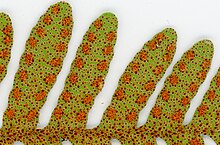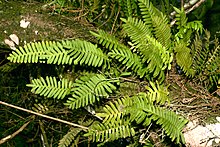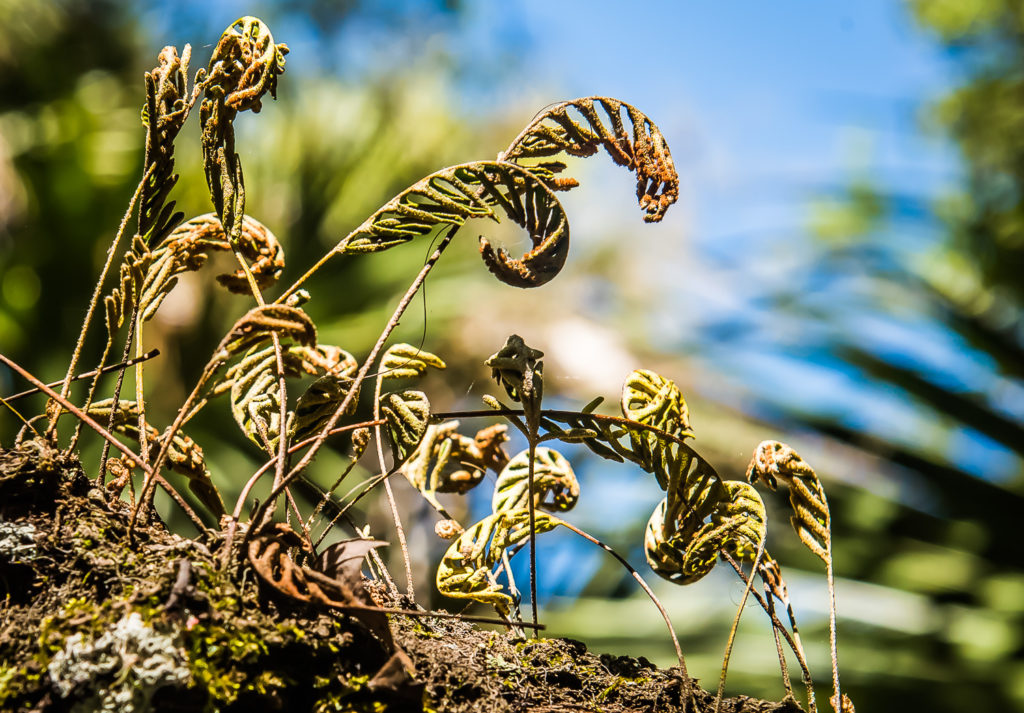This remarkable fern, known for its ability to seemingly come back to life after appearing desiccated and dead, is a true marvel of the plant world. Its unique characteristics and survival strategies make it an enchanting subject of study, offering insights into the resilience and adaptability of nature.
A Miraculous Transformation
The Resurrection Fern gets its name from its extraordinary ability to withstand extreme dehydration and then revive with the return of moisture. During dry periods, the fern’s fronds curl up and turn brown, giving the appearance of a lifeless, withered plant. However, with the onset of rain or increased humidity, the fronds unfurl and regain their lush green color within a matter of hours, as if the plant has been resurrected from the dead.
This incredible transformation is made possible by the fern’s cellular structure, which allows it to lose up to 97% of its water content without suffering permanent damage. In comparison, most plants can only survive a water loss of about 10-15%. The Resurrection Fern’s cells contain special proteins that stabilize their structure during dehydration, preventing collapse and preserving the plant’s integrity.
Physical Characteristics
The Resurrection Fern is an epiphytic plant, meaning it grows on the surface of other plants without drawing nutrients from them. In Florida, it is commonly found growing on the branches of live oaks, cypresses, and other hardwood trees. The fern’s fronds are typically 4 to 12 inches long, with a leathery texture that helps reduce water loss.
The fronds are pinnately compound, meaning they have a central stem with leaflets arranged on either side. When hydrated, the fronds are a vibrant green, with a slightly wavy appearance that adds to their visual appeal. The underside of the fronds is dotted with sori, small clusters of sporangia that produce spores, allowing the fern to reproduce.
Ecological Role
The Resurrection Fern plays a vital role in Florida’s ecosystems. As an epiphyte, it does not harm its host tree, instead using it as a platform to access sunlight and moisture. This relationship is mutually beneficial, as the fern provides additional habitat and food sources for various wildlife species.
Insects, spiders, and other small invertebrates often take shelter among the fronds of the Resurrection Fern. Birds and other animals may use the fern as nesting material or forage for insects living within its dense foliage. The fern also contributes to the overall biodiversity of the forest, supporting a complex web of life that thrives in Florida’s unique habitats.
Historical and Cultural Significance
The Resurrection Fern has long been admired for its resilience and beauty. Native American tribes, including the Seminole, recognized the plant’s remarkable properties and incorporated it into their traditional practices. The fern was often used in medicinal remedies, believed to possess healing qualities that could revive the body and spirit.
Early settlers in Florida were also captivated by the fern’s miraculous revival. It became a symbol of endurance and renewal, embodying the pioneering spirit of those who sought to make a life in the often challenging environment of the American South. Today, the Resurrection Fern continues to inspire awe and wonder, serving as a living testament to the incredible adaptability of nature.
Human Uses
While the Resurrection Fern is primarily valued for its ecological and aesthetic contributions, it has also found practical uses in various contexts. Gardeners and landscapers often incorporate the fern into their designs, using it to create natural, low-maintenance greenery on trees, rocks, and walls. Its ability to thrive in shaded, humid environments makes it an excellent choice for enhancing the beauty of Florida gardens.
In addition to its ornamental value, the Resurrection Fern has been studied for its potential applications in fields such as medicine and biotechnology. The proteins and mechanisms that enable the fern to survive extreme dehydration could offer insights into developing drought-resistant crops or preserving biological materials. As research continues, the fern may yield new discoveries that benefit both science and society.
Conservation and Challenges
Despite its resilience, the Resurrection Fern faces challenges in the modern world. Habitat loss due to urban development and deforestation poses a significant threat to its populations. As natural forests are cleared for agriculture, housing, and other uses, the fern’s preferred habitats are diminished, making it more difficult for the plant to thrive.
Climate change also presents a looming challenge. Altered precipitation patterns, increased temperatures, and more frequent extreme weather events can affect the growth and distribution of the Resurrection Fern. Conservation efforts focused on preserving natural habitats and promoting sustainable land-use practices are essential to ensure the long-term survival of this remarkable plant.
A Personal Encounter
One of my most memorable encounters with the Resurrection Fern occurred during a summer hike in the Apalachicola National Forest, a sprawling expanse of wilderness in the Florida Panhandle. As I walked along a shaded trail, the dense canopy of live oaks and cypresses provided a cool respite from the heat. The air was thick with humidity, and the forest floor was carpeted with a lush understory of ferns and mosses.
I came across a massive live oak, its gnarled branches draped with clusters of Resurrection Fern. The fern’s fronds were a deep, vibrant green, glistening with moisture from a recent rain. I paused to marvel at the intricate patterns of the fronds, each leaflet delicately veined and perfectly symmetrical. The scene was a testament to the resilience and beauty of nature, a reminder of the intricate connections that sustain life in the forest.
As I continued my hike, I noticed several other trees adorned with Resurrection Fern, each displaying the same miraculous revival after the rain. The experience was both humbling and inspiring, a reminder of the incredible adaptability of nature and the enduring spirit of the plants and animals that call Florida home.
Conclusion
The Resurrection Fern is more than just a plant; it is a symbol of the resilience and adaptability of nature. Its ability to survive extreme dehydration and revive with the return of moisture is a testament to the remarkable strategies that plants have evolved to thrive in challenging environments. From its ecological role to its historical and cultural significance, the Resurrection Fern is a vital component of Florida’s natural heritage.
As we continue to face the challenges of habitat loss, climate change, and other environmental pressures, it is crucial to recognize and protect the valuable contributions of plants like the Resurrection Fern. By preserving the natural habitats where these plants thrive and promoting sustainable practices, we can ensure that future generations will have the opportunity to marvel at the beauty and resilience of the Resurrection Fern.
So, the next time you find yourself exploring the forests of Florida, take a moment to appreciate the miraculous revival of the Resurrection Fern. Whether you’re marveling at its lush green fronds after a rain, observing the wildlife it shelters, or simply enjoying the shade it provides, you are witnessing a living legacy of the natural world. In doing so, you honor not only the plant itself but also the intricate web of life that it supports and the timeless connection we share with nature.
Pleopeltis polypodioides
Pleopeltis polypodioides, common name resurrection fern, is a species of creeping, coarse-textured fern native to the Americas and Africa.
Description
The evergreen fronds of Pleopeltis polypodioides are 25 cm high by 5 cm wide and monomorphic. The leathery, yellow-green pinnae (leaflets) are deeply pinnatifid, oblong to narrowly lanceolate, usually widest near middle, occasionally at or near base. It attaches to the limbs of its host plant with a branching, creeping, slender rhizome, which grows to 2 mm in diameter. The scales are lanceolate, with light brown base and margins, and having a dark central stripe.

The gametophytes (the haploid gamete producers) develop from very small spores that float in the air and are deposited on moist tree branches. These spores are produced in sporangia that develop on the leaves of the fern's sporophyte. The fern can also reproduce by the division of its rhizomes.
On the underside of the blades, the sori (reproductive clusters) are round, discrete, and sunken. Their outline can be seen as raised dimples on the upper surface. They are typically near the outer edge, and occur on all but the lowest pinnae of fertile fronds. Indusia are absent. Sporangia are yellow to brown at maturity. Spores are produced from summer to fall.
Distribution and habitat

Pleopeltis polypodioides resides in the hardwood forests of southeastern United States in areas including Delaware, Maryland, the Carolinas, Virginia, West Virginia, Illinois, Ohio, Alabama, Georgia, Florida, Mississippi, Arkansas, Texas and Oklahoma. This fern can also be found in areas such as subtropical America, parts of southern Africa and other humid or sub-humid climate areas.
This fern is an epiphyte, or air plant, which means it attaches itself to other plants and gets its nutrients from the air and from water and nutrients that collect on the outer surface of bark. The resurrection fern lives on the branches of large trees such as cypresses and can often be seen carpeting the shady areas on limbs of large oak trees repeatedly exposed to rainfall. However, it is known to grow on the surfaces of rocks and dead logs as well. It is often found in the company of other epiphytic plants, such as Spanish moss.
Physiology and rehydration
Pleopeltis polypodioides gets its common name "resurrection fern" because it can survive long periods of drought by curling up its fronds and appearing desiccated, grey-brown and dead. However, when just a little water is present, the fern will uncurl and reopen, appearing to "resurrect". It has been estimated that these plants could last 100 years without water and still revive after a single exposure.[3][4]

The roots have evolved to function as anchors to tree bark. They have been found to be inefficient in absorption. When in clustered groups of ferns on the bark of trees, the increased transpiration of the ferns and bark allows the middle ferns of the cluster to remain open longer than ferns on the outside. The relative humidity of the air and the closing rate of the leaves of the ferns is an inverse relationship. The greater the humidity, the slower the leaves close because of prolonged exposure to moisture in the air.[5]
Pleopeltis polypodioides can severely desiccate and lose almost all of its water. Experiments have shown it can lose up to 97% and remain alive, though more typically, it loses around 76% in dry spells.[6][page needed] For comparison, most other plants would die after losing only 8–12% water. Upon rainfall or even minute exposures to water, they can fully rehydrate and return to a normal state in 24 to 48 hours.[3][7] Following substantial exposures to moisture, there is an immediate increase in its water content of up to 50% after the first hour and 65–70% after three hours.[7] When it regains moisture, the fern can once again become photosynthetically active, increasing its metabolism and release of organic compounds that provide nutrients for symbiotic bacteria that allow them both to thrive.
At least one study has shown association between P. polypodioides and moss,[8] indicating that this fern may rely on moss for some of its water needs.

Resurrection ferns accumulate sugar in dehydrated cells in order to protect them and stabilize the membranes and proteins in the dry state. By accumulating sugar, the cells can maintain hydrogen bonds between necessary macromolecules needed for their structure. An interesting feature of the resurrection fern is it does not immediately take up water after having been in a desiccated state. Pleopeltis polypodioides has a porous cell structure network that can expand and rearrange to accommodate absorbing three to four times its weight in water after being exposed.[9]
When the fronds "dry", the mesophyll deforms, which causes the lamina to curl and exposes the underside and show the peltate scales. The peltate scales help prevent photooxidation and mechanical damage, as well as assist in quick rehydration.[10] The fern fronds contain canal cells in the center of their surface scales that direct water to the epidermis of the fern leaves, allowing absorption. The ability of the fern fronds to unroll after exposure to desiccation is attributed to the large cells of the upper epidermis along the midrib of the frond that increase in width more than any other epidermal cell, which forces the fronds to uncurl and flatten out.[5]
Pleopeltis polypodioides has adapted to survive desiccation with the ability of its cell walls to deform and reform, without bursting or rupturing. It has been observed that dehydrins may allow the cell walls of the fern fronds and leaves to deform and reform in times of extreme drought followed by water exposure, due to large fluctuations in water content. Dehydrins were found to be expressed only when the fern was drying or in the desiccated state, with the dehydrins located on the outsides of the cells near the cell walls, allowing the leaves and fronds of the ferns to deform and reform accordingly.[11]
Thermoluminescence of the resurrection fern has been tested to observe at what temperatures it occurs and therefore shows what temperatures and amount of desiccation the ferns can tolerate before their chloroplasts lose the energy they have stored for the plant in the form of light emissions. One study found the resurrection fern required high temperatures before thermoluminescence occurred at around 50 °C, whereas other desiccation-tolerant plants showed thermoluminescence at 40 °C.[12] The thermoluminescent activity of the resurrection fern increased as it was exposed to six separate but consecutive flashes of green safelight at its leaves. Because thermoluminescence from the fern fronds was not observed until higher temperatures, this hints that the fern’s chloroplasts may have a mechanism to withhold and store energy for the fern as it desiccates, allowing it to survive higher temperatures and extreme periods of desiccation.[12]
Reproduction
The fern has spores on the bottom of the fronds, contained in sori. Sori can be found aligned in rows on the underside of fertile fronds. They start as yellow, but as they mature, they turn brown and split.[13] The fern sporulates in summer and early fall. Rhizome sections are also viable offspring and can root themselves in new medium.
See also
References
- ^ NatureServe. "Pleopeltis polypodioides Resurrection Fern". NatureServe Explorer. Arlington, Virginia. Retrieved 9 October 2020.
- ^ a b c Hassler, Michael. "Pleopeltis polypodioides". World Ferns. Retrieved 10 December 2024.
- ^ a b North Carolina Cooperative Extension (17 Feb 2012). "Resurrection ferns make awe-inspiring comebacks". Wayne County Center--North Carolina Cooperative Extension. Goldsboro, North Carolina: North Carolina State University. Archived from the original on 30 March 2013. Retrieved 14 Jul 2015.
- ^ Stevenson, Carrie (2 Sep 2013). "Resurrection Ferns". Gardening in the Panhandle. Gainesville, Florida: Institute of Food and Agricultural Sciences. Archived from the original on 14 July 2015. Retrieved 14 Jul 2015.
- ^ a b Potts, Roberta; Penfound, Wm. T. (1948). "Water Relations of the Polypody Fern, Polypodium polypodioides (L.) A. S. Hitchcock". Ecology. 29 (1): 43–53. Bibcode:1948Ecol...29...43P. doi:10.2307/1930343. JSTOR 1930343.
- ^ Moran, Robbin C. (2004). A Natural History of Ferns. Timber Press. ISBN 0881926671.
- ^ a b Jackson, Evelyn F.; Echlin, Haley L.; Jackson, Colin R. (2006). "Changes in the phyllosphere community of the resurrection fern, Polypodium polypodioides, associated with rainfall and wetting: Changes in the phyllosphere community of the resurrection fern". FEMS Microbiology Ecology. 58 (2): 236–246. doi:10.1111/j.1574-6941.2006.00152.x. PMID 17064265.
- ^ "Proceedings of the Oklahoma Academy of Science". Archived from the original on 2005-03-17. Retrieved 2005-03-14.
- ^ Helseth, L. E.; Fischer, T. M. (2005-06-09). "Physical mechanisms of rehydration in Polypodium polypodioides, a resurrection plant". Physical Review E. 71 (6): 061903. Bibcode:2005PhRvE..71f1903H. doi:10.1103/PhysRevE.71.061903. ISSN 1539-3755. PMID 16089761.
- ^ Prats, Kyra A; Brodersen, Craig R (2021-08-02). "Desiccation and rehydration dynamics in the epiphytic resurrection fern Pleopeltis polypodioides". Plant Physiology. 187 (3): 1501–1518. doi:10.1093/plphys/kiab361. ISSN 0032-0889. PMC 8566288. PMID 34618062.
- ^ Layton, B. E.; Boyd, M. B.; Tripepi, M. S.; Bitonti, B. M.; Dollahon, M. N. R.; Balsamo, R. A. (2010). "Dehydration-induced expression of a 31-kDa dehydrin in Polypodium polypodioides (Polypodiaceae) may enable large, reversible deformation of cell walls". American Journal of Botany. 97 (4): 535–44. doi:10.3732/ajb.0900285. PMID 21622416.
- ^ a b Maslenkova, T. L.; Homann, P. H. (2000). "2000CRABS..53d..99M Page D99". Comptes Rendus de l'Académie Bulgare des Sciences. 53: 4. Bibcode:2000CRABS..53d..99M.
- ^ ANPS Webmaster (2018-01-16). "Know Your Natives – Resurrection Fern". Arkansas Native Plant Society. Retrieved 2024-12-07.
- Flora of North America: Pleopeltis polypodioides var. michauxiana
- Flora of Zimbabwe: Polypodium polypodioides subsp. ecklonii
- Polypodium polypodioides Archived 2007-02-22 at the Wayback Machine from the Hardy Fern Library
- The Relationship Between Pleopeltis polypodioides (Polypodiaceae) and Associated Mosses Archived 2005-03-17 at the Wayback Machine by John W. Story II
- Pleopeltis michauxiana Florida Plant Atlas Pleopeltis michauxiana
- Pleopeltis polypodioides Florida Plant Atlas Pleopeltis polypodioides
- NanoRacks-Wheaton Academy-Resurrection Plant Growth Experiment in Microgravity (NanoRacks-WA-Resurrection Plant Growth) - 08.27.15 NASA mission that took Resurrection Fern into space
